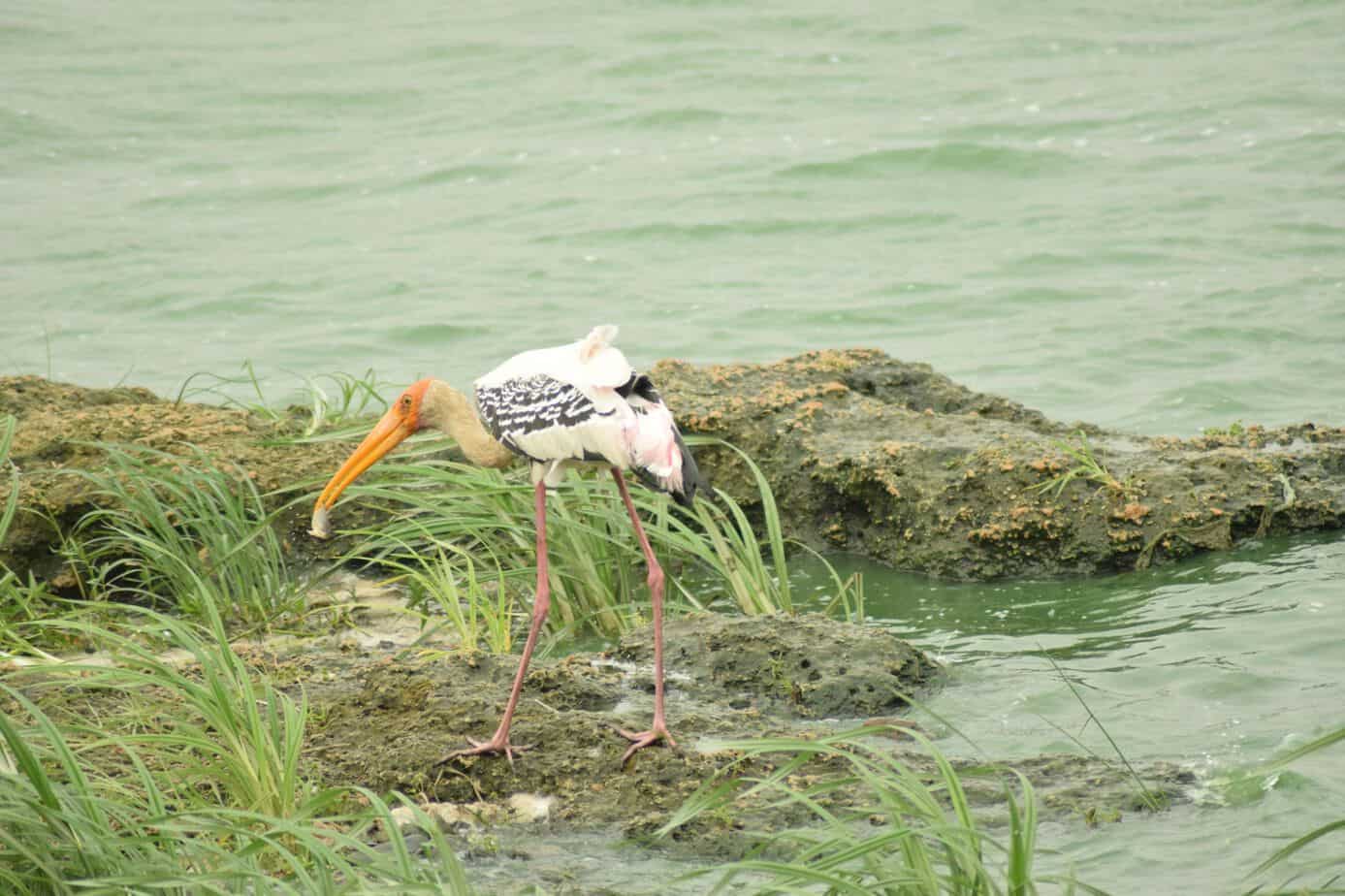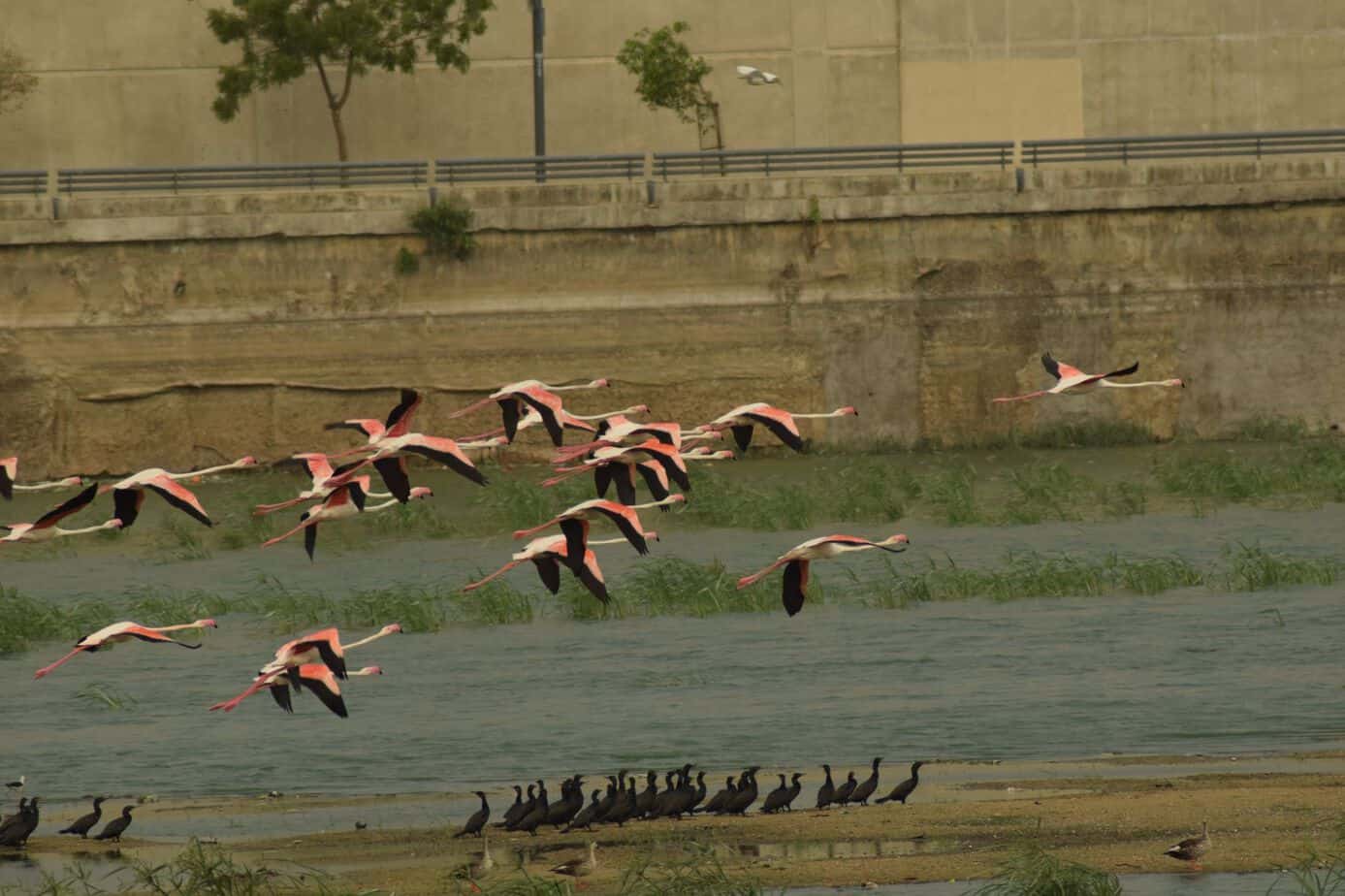For the first time ever, the largest of the flamingo species, the Greater flamingos, one of the most widely recognized waders in the world, were spotted in the newly developed Sabarmati river front in Ahmedabad, much to the delight of citizens, especially the birders’ community.
“I was delighted when I spotted a huge flock of about 50 flamingos when I went for a walk on the riverfront,” said hobbyist wildlife photographer Vicky Chauhan, a chartered accountant residing just 200 metres from the riverfront. “While we have seen flamingos in areas near Ahmedabad in the Fatewadi area, this was the first time I saw them bang in the middle of the city”.
It seems that the cleaning of the river front two months back, especially the removal of about 10,000 tonnes of plastic garbage by about 60,000 volunteers, has provided a welcoming macro ecosystem along with a sustainable wetland that attracts birds, said Prashant Shah, member of the core committee of Bird Conservation Society of India, Gujarat. “Not just Greater flamingos, I have spotted various species of birds on the banks of Sabarmati for the first time this season, like Lesser Flamingos, Kingfisher, Painted Stork, Spot-billed Duck, Comb Duck, Median Egret, Cormorants, River Tern, Grey Heron, Pond Heron and Purple Heron”.
Flamingos have traditionally been sighted around Nalsarovar bird sanctuary, some 70 km from Ahmedabad and Thol, some 35 kms from Ahmedabad.
“Flamingos are migratory birds, and there are no rules about where one can find them,” said Bakul Trivedi, Secretary of Bird conservation Society of Gujarat, and a doctor by profession. “They know areas around Ahmedabad are good for them. So, if they find a conducive ecosystem, they will come. They need shallow, standing water that they can wade through, with planktons, mainly algae, which is their primary food. Earlier too, some 10 years ago, flamingos, were spotted in Sarkhej area where drainage water was left standing for a long time. Drainage water is rich in plankton. Unlike popular belief, Flamingos don’t eat fish. They gather the plankton in their inverted beaks when they wade through muddy water”.
Planktons flourish in shallow, standing waters. Hence, as Trivedi says, the biggest challenge in getting them to return to the Sabarmati is the erratic monsoon, that results in fluctuating water level.
Making the river bird-friendly
Flamingos were last seen some 10 years ago on the Sabarmati river bed, but after that, the condition of the river was not conducive to support plankton growth. Not just erratic rainfall, but the dumping of pollutants from sewer and chemical effluents from industries, had almost killed the river.
Keshav Verma, IAS and chairman of Sabarmati Riverfront Corporation said that till date, 42 illegal sewerage dump lines have been sealed by the AMC in an operation that started in 2011. Moreover, one sewerage treatment plant (STP) had been set up near Gandhi Ashram to treat sewerage water before it would be released in Sabarmati. Another STP near Shankar Bhuva area has been commissioned and will be operational by 2020, while two more STPs near Dafnala area and Kotarpur have been sanctioned and tendering process is going on.
“The BOD levels (Biological Oxgen Demand) have increased from 2 in 2005 to 6 after our efforts, while COD levels (Chemical Oxygen Demand) lie between 15 and 23, depending on the conditions, as per figures released by the Central Laboratory of AMC,” said Verma.
“The sighting of birds, especially flamingos is a positive endorsement of our efforts at bio-remidification of the river and stimulating oxygen levels,” added Keshav Verma. “Our efforts are to make the Sabarmati river front an ecological safety zone. The sighting of such a diverse variety of species in the middle of a humming metropolis like Ahmedabad proves that citizens can create such green zones if they put in the effort”.
Sabarmati Riverfront Project
Sabarmati Riverfront Development is an ambitious project of the Ahmedabad Municipal Corporation which aims to create a sustainable river environment and also develop social infrastructure along the banks of the Sabarmati, at a total projected investment of around Rs 1150 crores.
The development plan envisages more than 85 percent coverage of the river front property for non-commercial uses like greening, creating parks, gardens and green zones, so that people can connect with nature, added Verma. The project aims to create living spaces on both the eastern and western banks of Sabarmati river as it flows through Ahmedabad, by channelling the river to a constant width of 263m, so that the additional riverbed land be reclaimed to create 11.25 kms of public riverfront. The total land reclamation is 202.79 hectares.
Work on the project started in 2005 and the first phase of 11 kilometres of east and west embankments is complete. All the work on the lower level river promenade, which will provide a twenty-two-kilometre-long waterside pedestrian realm, is complete. All stretches of the promenade, river front street side, three boating stations, and two parks are complete and open for public use since 2014.
“We started the process of cleaning the river waters, and have systematically stopped the flow of drainage water and industrial waste into the Sabarmati, as was happening till 15 years back. Our aim is to enrich the bio-diversity of the river itself,” said Verma.
But the efforts to prevent dumping of untreated industrial waste into the river has not been a total success, which worries bird watchers like Prashant Shah. There have been delays in the implementation of the planned increase in STP capacity. As long as all the four planned STPs are not functional, about 60 MLD of sewage is dumped in the river, according to a report of AMC in 2018.
The birder community feels that this illegal dumping of chemical effluents will kill the river’s organic life making it unsuitable for bird ecology. But Verma is optimistic. “The second phase of river development is all about enriching and sustaining the quality of water in Sabarmati and along with municipal and other authorities, we will come down heavily on anyone flouting the norms,” assures Verma. “It is the result of our efforts that a once-dead river is alive again, with fish, and birds. We will ensure that this is taken forward”.
The river front development authorities and the Municipal Corporation have also planted more than 80,000 trees along the river’s banks. “We are trying to see if we can develop a part of the area as a bird conservation zone,” said Verma. “We plan to develop this in partnership with the citizens of Ahmedabad, as such conservation efforts can be successful only with active partnership of the people. We wish to establish this kind of city living space that will enhance biodiversity in the city and improve quality of living space for people.”


A silver lining in the sable cloud, for a welcome change. Makes for a meaningful develooment, in tandem; to create space for quality living for human beings and betterment of natural environment also for pleasing winged creations!